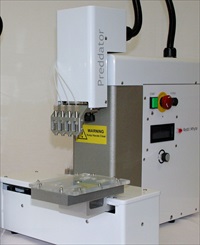Members Login

Channels
Special Offers & Promotions
AstraZeneca uses Redd and Whyte Preddator Low-volume Microplate Dispenser to Increase Throughput by a Third and Improve Assay Accuracy
Redd&Whyte, an expert supplier of liquid handling automation for drug discovery and life science research applications, today announced its Preddator system has been integrated in an assay workcell by AstraZeneca, to meet a generic high throughput nano-litre dispensing application.
 Using the Preddator system, the assay run time has been significantly reduced, while maintaining the dispensing consistency and flexibility of the original workcell.
Using the Preddator system, the assay run time has been significantly reduced, while maintaining the dispensing consistency and flexibility of the original workcell.
Scientists in the Oncology Group at AstraZeneca (Alderley Park, UK) integrated the Preddator system as an additional dispensing module to complement a Labcyte ECHO 555 acoustic reformatter in a high throughput cell-based screening workcell. The system is routinely used to perform 2-dimensional dose response dispensing for drug combination screening. It uses the nano-litre dispensing platform across over 250 plates in 384-well format to DMSO backfill volumes ranging between 20 and 100nL over ~36 hrs per batch in each run. The main function of the Preddator system is to carry out the DMSO backfill step to maintain a constant level of DMSO across all assay wells. This is important due to the nature of DMSO-sensitivity of cell-based assays being carried out and the effects that varying levels of DMSO may have on the growth of some cell lines.
John Vincent, Senior Research Scientist in Oncology at AstraZeneca commented: “It can take us around 36 hours to run an assay. Since DMSO is very hygroscopic and absorbs water quickly, this can change the concentration of the compound being screened. This can affect the accuracy of compound transfer by the Echo reformatter if the compound source plate is progressively hydrated and utilised by the system over an extended period. We knew if we could speed up the work-flow by having an efficient nano-litre dispenser to carry out the DMSO back-filling separately, we could improve the consistency of our compound dosing. This would make a significant saving of stock compounds as a result of requiring fewer stock plates and a shorter overall run time. The Preddator allows us to do this.”
Vincent continued: "We chose the Preddator system because it is able to dispense nano-litre volumes of different liquids and it has a small footprint which is a critical factor to fit into our bespoke automation workcell. The close collaborative effort between “Redd & Whyte” and PAA has been fundamental in successfully integrating the Preddator into our workcell under the Overlord3 robotic environment. The Preddator is being used as the basic workflow to provide DMSO back-fill after initial compound dosing by the ECHO reformatter. The new workflow with the Preddator is allowing us to reduce our compound dosing step by up to 30 percent. We believe that the Preddator is an effective nano-litre dispensing device which offers high speed, accurate dispensing in a very effective small footprint to complement the existing acoustic reformatter function.”
Roger Poole, Managing Director of Redd&Whyte said: "Dilutions can cause biological compounds to come out of solution so it is critical when preparing activity curves to keep DMSO at an optimum concentration. Keeping DMSO concentration at less than 0.1 percent of assay volume is difficult due to the lack of reliable Nanolitre-range liquid handlers.”
Poole added: “This is why we’re delighted that our Preddator system with its flexible range of precise low volume dosing is showing such good performance at AstraZeneca. Their results demonstrate to scientists that want to save time and improve assay accuracy when running screens that they should look at integrating a Preddator low-volume microplate dispenser into their workflow.”
Media Partners


